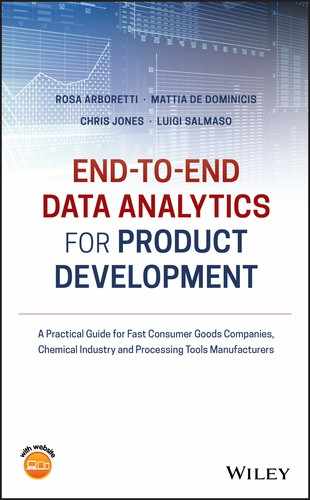Preface
The fast‐moving consumer goods (FMCG) industry includes a variety of sectors, from household products to food and beverages to cosmetics and over‐the‐counter (OTC). Despite products being very different in terms of their intended use, benefits, and the way they are regulated, there is a common approach to the method of developing them and identifying the solution for consumers. The process of innovation is similar: starting from the consumer understanding, identifying the insights that are most relevant, and then proceeding to develop an idea. A solution can solve a problem initially at the conceptual level, then moving across to an actual prototype, and then finally to new product development (NPD). No matter the segment, the appropriate use of data presents a value‐adding opportunity to NPD.
There is a great focus in the industry around using big data derived from multiple sources, which are easily accessible via the internet. Today, information derived from many global applications is increasingly measuring different aspects of our lives. However, the focus is now to gain business value from such data. Surprisingly, the use of data for product development in most cases is not robustly established; a clear connection between the experts in statistics/data analytics and the product developers within the main FMCG companies needs to be established.
The focus is to develop better products for consumers by investing the right features and to support faster developments to ultimately limit the number of experiments. So, the scope of this book is to demonstrate how actual statistics, data analytics and design of experiment (DoE) can be widely used to gain vital advantages with respect to speed of execution and lean formulation capacity. The intention is to start from feasibility screening, formulation, and packaging development, sensory tests, etc. introducing relevant techniques for data analytics and guidelines for data interpretation. Process development and product validation can also be optimized through data understanding, analysis and validation.
Throughout the book, there is an intentional balance between the discussion of real case studies and topic explanations made as clear and intuitive as possible. Details on statistical and analytical tools are presented in sections denoted as Stat Tools. Each case study includes a guide to apply the proposed techniques with Minitab, a widely used general‐purpose statistical software (Cintas, P. G., et al., 2012). Some examples with JMP software are also developed as online supplementary material.
This book is an exciting collaboration between expert Statisticians from the University of Padova and innovators/product developers from Reckitt Benckiser (RB) over more than 15 years. The passion and the involvement of multiple people within RB and the University of Padova in various projects have allowed for the development of the examples discussed in this book. A big thanks goes to the leading management group and all people from RB who contributed directly or indirectly in giving inspiration to write this book.
Dr. Chris Housmekerides
SVP R&D RB
Head of Innovations & Operations, Hygiene Home
